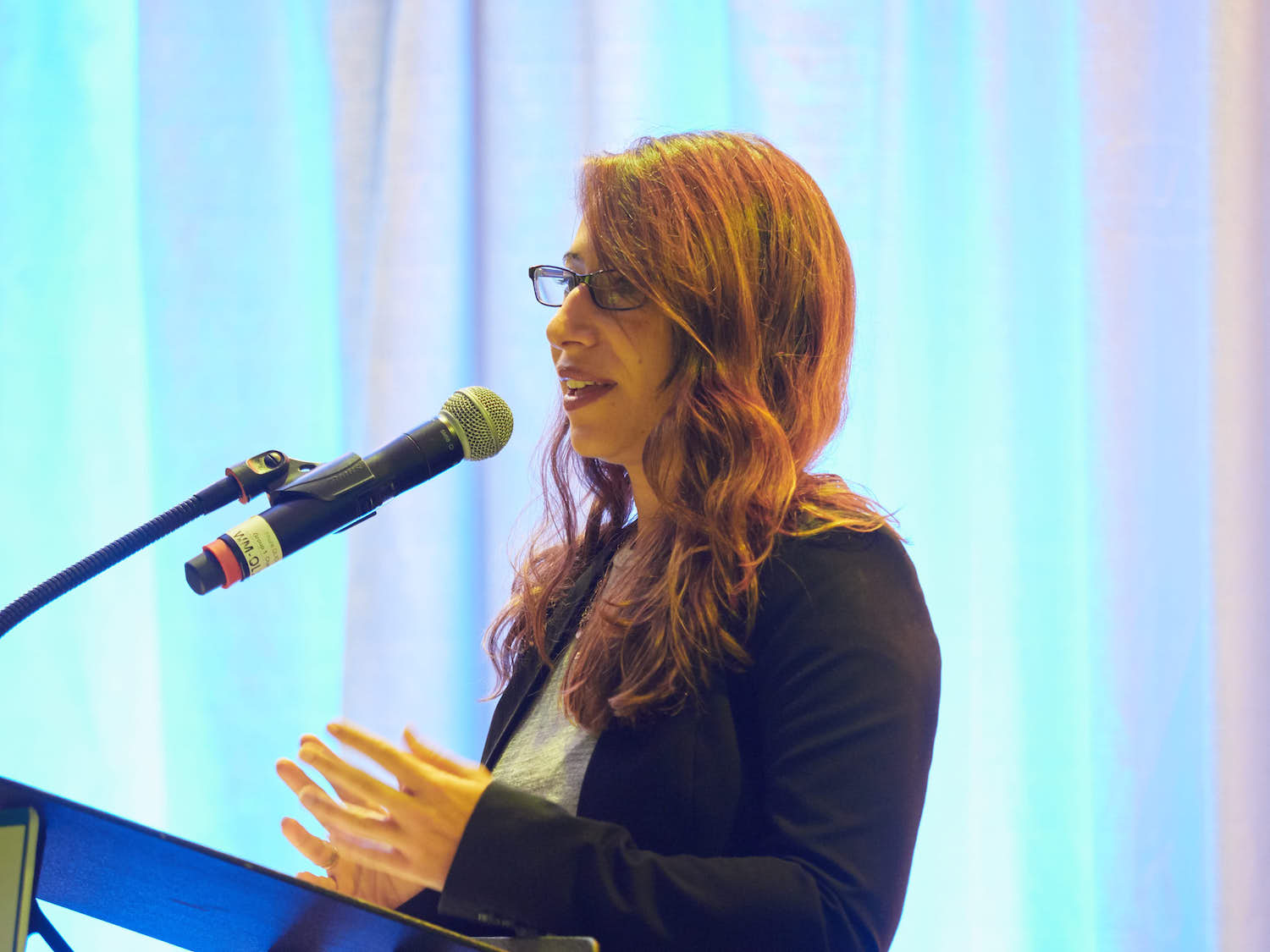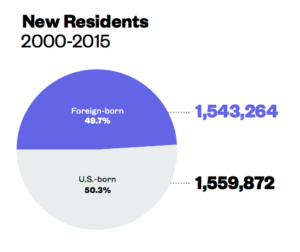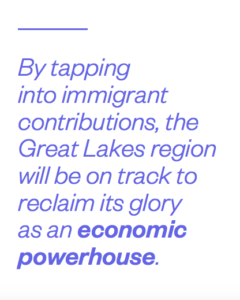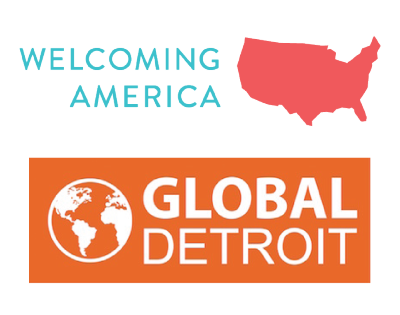Important Research released on Immigrants: Reviving the Great Lakes Region
By Steve Tobocman, Global Detroit
The Welcoming Economies Global Network was honored to serve as the launch pad for critically important research released by the New American Economy and the Great Lakes Metro Chambers Coalition at our October 24th Convening in Syracuse. The research focuses squarely on the Great Lakes region’s working-class and the positive impacts that immigrants have had on these workers.

Kate Brick, Director, State and Local Initiatives, New American Economy, sharing the report at the Convening.
A number of pundits have suggested that working-class Rust Belt voters swung the 2016 election. And the research affirms working-class frustrations and fears about the economy. According to the report, the Great Lakes region (roughly defined by upstate NY, PA, OH, MI, IN, IL, and WI, but more precisely defined by the metro and rural areas that touch those states) lost 1 million working-class jobs between 2000-2015 and saw real wages for working-class workers fall 6.4% over this period.
But then the report focuses on how growing immigrant populations in the same region actually are an important part of the solution to working-class ills, rather than a cause. The Great Lakes region faces some significant demographic challenges that threaten its economic viability, including sluggish population growth, population loss in rural areas, a rapidly aging workforce, and a brain drain of young college-educated residents who represent a critical component to long-term economic, job, and wage growth.
Here’s how immigrants are helping to offset those challenges:
 Population: While the U.S. population grew 14.2% from 2000-2015, the Great Lakes region grew only 4.3%, but immigrants accounted for half of that growth (with 1.5 million new immigrants to the region), helping to curb or reverse population decline in many cities;
Population: While the U.S. population grew 14.2% from 2000-2015, the Great Lakes region grew only 4.3%, but immigrants accounted for half of that growth (with 1.5 million new immigrants to the region), helping to curb or reverse population decline in many cities;- While rural areas lost 172,000 U.S.-born residents from 2000-2015, immigrants to these rural areas grew by 35,000, helping sustain those communities;
- Homeownership: While the number of U.S.-born homeowners in the Great Lakes region fell 0.6% from 2000-2015, the number of immigrant homeowners in the region grew 36.5% during this period – these homeowners are critical to neighborhood revitalization;
- Workforce: The Great Lakes Region had a 21.2% growth in the number of senior citizens (from 9 million to 11 million). While 51.1% of the U.S.-born population in the Great Lakes is working aged, 70% of its immigrant population is working aged, making them uniquely positioned to help fill shortages left by the baby boomer generation and fuel the labor force; and
- Talent: From 2014-15 alone, the Great Lakes region lost 74,000 college-educated U.S.-born Millennials (aged 22-34), but gained 18,000 college-educated immigrant Millennials, talent that is critical to economic growth.
Job Creation for U.S.-born Worker
Beyond these larger and important demographic patterns, however, the report details the ways in which immigrants are creating working-class jobs in key sectors of the Great Lakes economy, rather than taking jobs from the U.S.-born. In both health care (where 80% of all the net new jobs were created in the Great  Lakes region between 2000-2015) and manufacturing (the historic foundation of the regional economy), immigrant workers are helping fill critical skill shortages both in STEM and other areas requiring technical skill that are enabling Great Lakes companies and industries compete, expand, and invest in ways that are creating tens of thousands of working-class jobs.
Lakes region between 2000-2015) and manufacturing (the historic foundation of the regional economy), immigrant workers are helping fill critical skill shortages both in STEM and other areas requiring technical skill that are enabling Great Lakes companies and industries compete, expand, and invest in ways that are creating tens of thousands of working-class jobs.
Manufacturing
In manufacturing for example, immigrants have helped provide the talent to enable Great Lakes manufacturing to grow in ways that translate to job creation and real wage growth for working-class workers. While immigrants comprised 7.3% of the Great Lakes population, they comprise 16.1% of all STEM workers and 16.2% of the STEM jobs in advanced manufacturing, the area of fastest manufacturing job growth. As a result over 400,000 new jobs in Great Lakes manufacturing were created in just the past five years. The 8.5% growth (faster than overall job growth in the Great Lakes economy) included 250,000 new working class manufacturing jobs, 92.9% of which went to U.S.-born workers. Average wages also grew by 2.3% for working-class manufacturing workers during this five-year period.
Agriculture
The report also chronicles the Great Lakes region’s agricultural sector, where 50% of jobs are occupied by those with less than a bachelor’s degree. 80% of those jobs are occupied by U.S.-born workers, whereasimmigrants have been critical to filling a number of jobs that require heavier physical labor, persevering undesirable conditions or other challenges. In fact, immigrants fill 48.2% of the butcher jobs, 45.2% of the packaging positions, 30.7% of the field workers, 29.7% of the workers in animal production (including dairy and livestock), and 23.8% of the workers in crop production. By occupying these jobs and filling critical labor shortages, immigrants not only support upstream jobs (farm managers, owners, etc.), but help create downstream jobs (those who drive produce and milk to market, wholesalers, food processing). Growth in these downstream industries has helped create jobs for U.S.-born workers in the Great Lakes region. In fact, between 2000-2015, there was:
- 49.4% growth in the number of U.S.-born drivers in the agricultural sector;
- 61.1% growth in the number of U.S.-born jobs as wholesalers in raw farm products; and
- An addition of 16,586 jobs filled by U.S.-born workers in food processing
The economic realities—that immigrants are powering job creation in the Great Lakes region—are felt every day from Syracuse to Cincinnati. And leaders from these cities have on-the-ground experience about how immigrants are adding to the prosperity of the Great Lakes region, not taking away. It’s why so many of us are encouraging immigration as a strategy to respond to the real economic challenges that America’s working-class have felt. The report sums up the work of our WE Global Network best:
Indeed, many government and business leaders in the Great Lakes region, including local chambers of commerce, economic development agencies, nonprofit leaders, mayors, and governors, fully recognize that immigrants represent a lifeline for their communities, rather than a drain on them. Such leaders have launched more than 20 local economic development programs specifically designed to welcome, retain, and integrate immigrants into both urban revitalization and economic growth efforts. This is being done largely through the Welcoming Economies Global Network, a program of Welcoming America run in partnership with Global Detroit. Such efforts have put the Great Lakes region far ahead of other parts of the country and made it a powerful example. (Report pp. 45-46)



